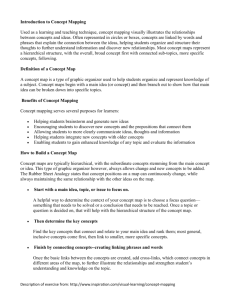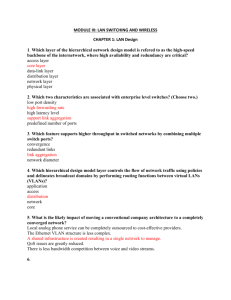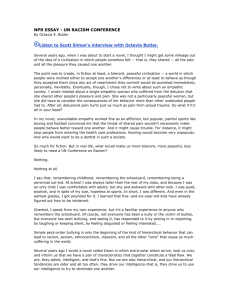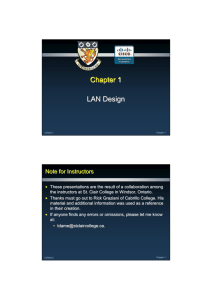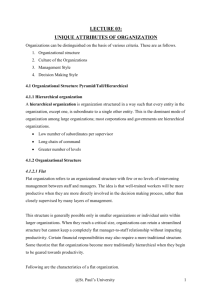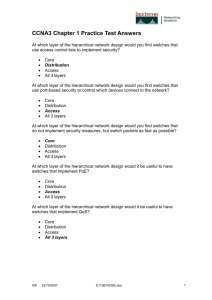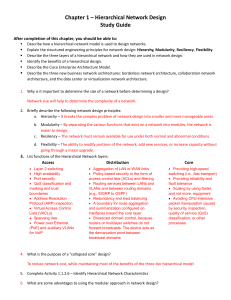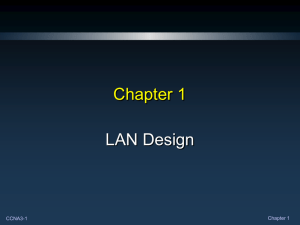Chapter 1 - wmmhicks.com
advertisement
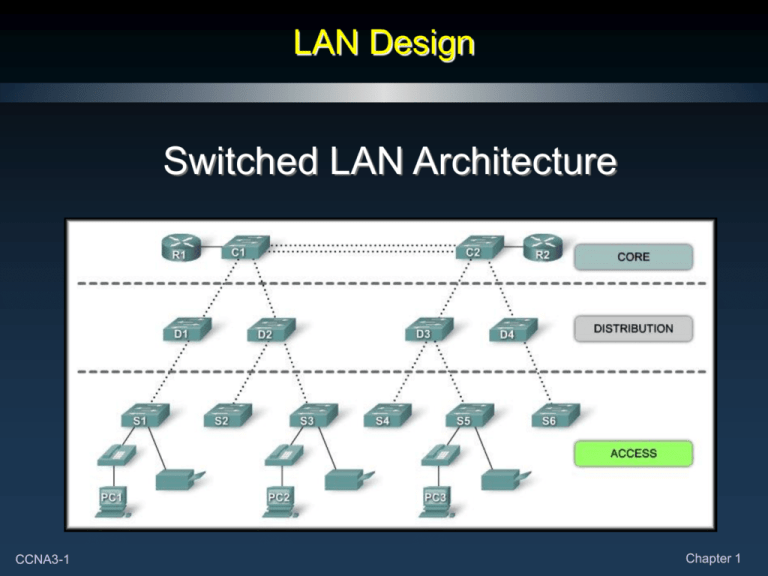
LAN Design Switched LAN Architecture CCNA3-1 Chapter 1 Switched LAN Architecture • When building a LAN that satisfies the needs of a small or medium-sized business, your plan is more likely to be successful if a hierarchical design model is used. • Divided into discrete layers. • Each layer has a specific purpose. • Becomes modular – maintenance, performance. CCNA3-2 Chapter 1 Switched LAN Architecture CCNA3-3 Chapter 1 Access Layer • Interfaces with end devices. • Routers, switches, bridges, wireless access points. • Provides a means of connecting and controlling which devices are allowed to communicate on the network. CCNA3-4 Chapter 1 Distribution Layer • • • • Aggregates (funnels) Access Layer traffic. Controls traffic flow with security or routing policies. Defines broadcast domains. Routing of VLANs (Virtual LANs). CCNA3-5 Chapter 1 Core Layer • • • • High speed backbone of the network. Must be highly available and redundant. Must be capable of quickly forwarding large amounts of data. Smaller networks – collapsed model (Core and Distribution). CCNA3-6 Chapter 1 Medium Sized Business Logical Layout Physical Layout CCNA3-7 Chapter 1 Benefits of a Hierarchical Network • Benefits: • Scalability • Redundancy • Performance • Security • Manageability • Maintainability CCNA3-8 Chapter 1 Benefits of a Hierarchical Network Scalability Hierarchical Networks can be expanded easily. CCNA3-9 Chapter 1 Benefits of a Hierarchical Network Redundancy CCNA3-10 Redundancy at the core and distribution layers ensure availability. Chapter 1 Benefits of a Hierarchical Network Performance Link aggregation and high performance distribution and core CCNA3-11 layer switches provide near-wire speed at all layers. Chapter 1 Benefits of a Hierarchical Network Security Port security at the access layer and policies at the distribution layer make the network more secure. Chapter 1 CCNA3-12 Benefits of a Hierarchical Network Manageability Configurations Additional Switch Functionality Rapid Recovery Easier Troubleshooting CCNA3-13 Consistency among switches at each layer makes management more simple. Chapter 1 Benefits of a Hierarchical Network Maintainability The modular design allows a network to scale easily without becoming over-complicated or burdensome. Chapter 1 CCNA3-14 Principles of Hierarchical Network Design • Just because a network is hierarchical, it doesn’t mean it’s well designed. • Network Diameter: • The number of devices that a packet has to cross before it reaches its destination. • Bandwidth Aggregation: • After the bandwidth requirements of the network are known, links between specific switches can be aggregated or combined to provide higher bandwidth. • Redundancy: • The practice of providing multiple paths to a destination or multiple instances of a device. CCNA3-15 Chapter 1 Principles of Hierarchical Network Design • Network Diameter: • For PC1 to communicate with PC3, the data must traverse 6 intermediate switches. • In this case, the network diameter is 6. • Each switch introduces some latency. • In a hierarchical network, network diameter is always going to be a predictable number of hops between the source and destination devices. CCNA3-16 Chapter 1 Principles of Hierarchical Network Design • Bandwidth Aggregation: • Link aggregation allows multiple switch port links to be combined so as to achieve higher throughput between switches. • The determining factor is using link aggregation is the requirements of the user applications. CCNA3-17 Chapter 1 Principles of Hierarchical Network Design • Redundancy: • Redundancy is one part of creating a highly available network. • Multiple links between switches or multiple devices. • It can get expensive and most likely will not be done on the access layer because of the cost and variety of devices. • It is feasible at the distribution and core layers. CCNA3-18 Chapter 1 Considerations for Network Switches • Data Stores and Data Servers Analysis: • When analyzing traffic on a network, consider the location of the data stores and data servers. • Consider both client-server and server-server traffic. CCNA3-19 Chapter 1 Switch Features – Hierarchical Network • Access Layer Switch Features: Port Security Link Aggregation VLANs PoE FastEthernet/Gigabit Quality of Service (QoS) CCNA3-20 Chapter 1 Switch Features – Hierarchical Network • Distribution Layer Switch Features: Layer 3 Support Link Aggregation High Forwarding Rate Redundant Components Gigabit/10 Gigabit Quality of Service (QoS) Security Policies CCNA3-21 Chapter 1 Switch Features – Hierarchical Network • Core Layer Switch Features: Layer 3 Support Link Aggregation Very High Forwarding Rate Gigabit/10 Gigabit Redundant Components Quality of Service (QoS) CCNA3-22 Chapter 1

